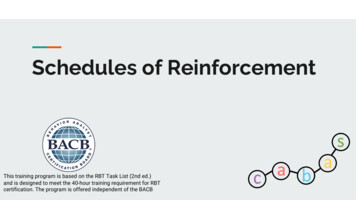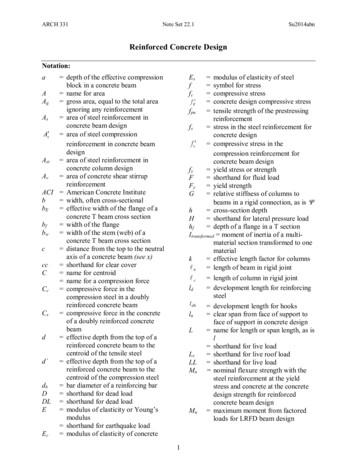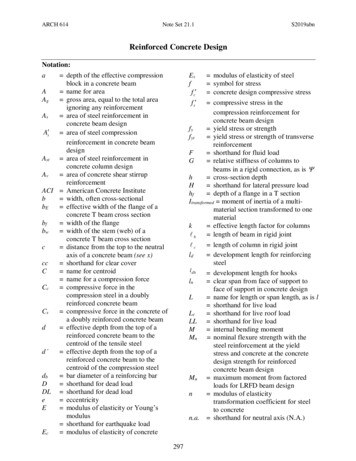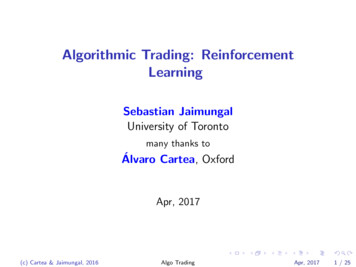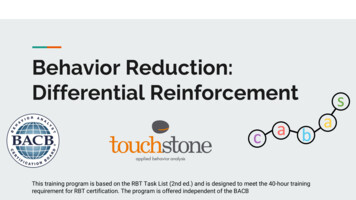
Transcription
Behavior Reduction:Differential ReinforcementThis training program is based on the RBT Task List (2nd ed.) and is designed to meet the 40-hour trainingrequirement for RBT certification. The program is offered independent of the BACB
References Cooper, J. O., Heron, T. E., & Heward, W. L. (2020). Applied Behavior Analysis (3rd ed.). Hoboken, NJ:Pearson. Shitbutani, Makoto (2017). The ABA visual language: Applied behavior analysis. Rhinobook. Behavior Analyst Supervisor (BAS) RBT Study Guide https://behavioranalystsupervisor.com/ RBT Task List (2nd Edition) https://www.bacb.com/rbt/
RBT Task List:D4- Differential ReinforcementProcedures
Definition “Reinforcing only those responses within a response classthat meet a specific criterion along some dimension(s) andplacing all other responses in the class on extinction(Cooper, Heron, & Heward, pg. 693)
Differentialreinforcement always includes thefollowing two principles ofbehavior:*Reinforcement*Extinction
Differential Reinforcement ProceduresProcedures that involve reinforcement and extinction DRO Differential Reinforcement of Other Behaviors DRA Differential Reinforcement of Alternative Behaviors DRI Differential Reinforcement of Incompatible Behaviors
Differential Reinforcement of other behavior (DRO) “A procedure for decreasing problem behavior in whichreinforcement is contingent on the absence of the problembehavior during or at specific times (i.e., momentary DRO);sometimes called differential reinforcement of zero rates ofresponding or omission training.)”(Cooper et al, 2017, pg. 694)
DRO(Shitbutani, 2017)
DROGuidelines:1.2.3.4.Time interval (usual), also momentary time samplingReinforcement contingent upon target behavior NOT being observedReset the interval is the target behavior occurs within itInitial interval at least as frequently as target behaviora. We want to be sure reinforcement for non-engagement iscontacted5. Must be careful you do not reinforce other inappropriate behavior
DROGuidelines Continued:6. Gradually increase interval as problem behavior decreases7. Option to decrease interval (increase reinforcement) in settings ortimes when behavior is more problematic8. Extend DRO to other settings and people
Demonstration of DRO
Differential Reinforcement of alternative behavior(DRA) “A procedure for decreasing problem behavior in whichreinforcement is delivered for a behavior that serves as adesirable alternative to the behavior targeted for reductionand withheld following instances of the problem behavior(e.g., reinforcing completion of academic worksheet itemswhen the behavior targeted for reduction is talk-outs”(Cooper et al, 2017, pg. 693)
DRA(Shitbutani, 2017)
DRAShould be a functional alternative!Reinforcement typically introduced on continuous schedule then fadedlaterMost common differential reinforcement technique
Demonstration of DRA
Differential Reinforcement of Incompatiblebehavior (DRI) “A procedure for decreasing problem behavior in whichreinforcement is delivered for a behavior that istopographically incompatible with the behavior targetedfor reduction and withheld following instances of theproblem behavior (e.g., sitting in a seat ins incompatiblewith walking around the room” (Cooper et al., 2017, pg.693).
DRI(Shitbutani, 2017)
DRIThis is a DRA procedure that uses a replacement behavior that CANNOT beperformed at the same time as the target behavior
DRA & DRIGuidelines:1. Attempt to select behaviors that are already in the learner’s repertoire2. Alternative or incompatible behavior should require equal or lesseffort than problem behavior3. Alternative or incompatible behavior should be likely to producereinforcement in natural environment when DRA/DRI is removed
DRA & DRIGuidelines Continued:4. Select reinforcer with same function as target behavior5. Continuous reinforcement then fade6. Place problem behavior on extinction
Demonstration of DRI
Differential Reinforcement of low rates (DRL) “A schedule of reinforcement in which reinforcement (a) followseach occurrence of the target behavior that is separated from theprevious response by a minimum interresponse time (IRT), or (b) iscontingent on the number of responses within a period of time notexceeding a predetermined criterion. Practitioners use DRLschedules to decrease the rate of behaviors that occur toofrequently but should be maintained in the learner’s repertoire”(Cooper, Heron, and Heward, pg. 694)
DRL
Demonstration of DRL
RBT PRACTICE QUESTIONS
You provide reinforcement to your client forclapping, and ignore him when he hits.a.b.c.d.Differential reinforcement of alternative behaviorDifferential reinforcement of incompatible behaviorDifferential reinforcement for lower rats of behaviorDifferential reinforcement of other behavior
You provide reinforcement to your client forclapping, and ignore him when he hits.a.b.c.d.Differential reinforcement of alternative behaviorDifferential reinforcement of incompatible behaviorDifferential reinforcement for lower rats of behaviorDifferential reinforcement of other behavior
Focus on increasing a desirable alternative behavior that directly or indirectly interferes with theperformance of the undesired target behavior.(i.e. reinforce knitting or giving a self manicure instead of biting nails; reinforce appropriate languageinstead of punishing swearing at others)a.b.c.d.Differential reinforcement of alternative behaviorDifferential reinforcement of incompatible behaviorDifferential reinforcement for lower rats of behaviorDifferential reinforcement of other behavior
Focus on increasing a desirable alternative behavior that directly or indirectly interferes with theperformance of the undesired target behavior.(i.e. reinforce knitting or giving a self manicure instead of biting nails; reinforce appropriate languageinstead of punishing swearing at others)a.b.c.d.Differential reinforcement of alternative behaviorDifferential reinforcement of incompatible behaviorDifferential reinforcement for lower rats of behaviorDifferential reinforcement of other behavior
Select the best definition for differential reinforcement, fromthe choices below:a.b.c.d.A stimulus that, when presented following a behavior, causes an overall INCREASE in thatbehavior over time.Providing greater reinforcement for better approximations of a target behavior, and placing otherbehaviors on extinction or on a less desirable reinforcement schedule.A stimulus that signals the availability of a reinforcer.A stimulus that, when presented following a behavior, causes an overall DECREASE in thatbehavior over time.
Select the best definition for differential reinforcement, fromthe choices below:a.b.c.d.A stimulus that, when presented following a behavior, causes an overall INCREASE in thatbehavior over time.Providing greater reinforcement for better approximations of a target behavior, and placingother behaviors on extinction or on a less desirable reinforcement schedule.A stimulus that signals the availability of a reinforcer.A stimulus that, when presented following a behavior, causes an overall DECREASE in thatbehavior over time.
Reinforcing progressively lower responserates.a.b.c.d.Differential reinforcement of higher rates of behaviorDifferential reinforcement of lower rates of behaviorDifferential reinforcement of other behaviorDifferential reinforcement of alternative behavior
Reinforcing progressively lower responserates.a.b.c.d.Differential reinforcement of higher rates of behaviorDifferential reinforcement of lower rates of behaviorDifferential reinforcement of other behaviorDifferential reinforcement of alternative behavior
A child is taught to raise their hand as an alternative to yelling out inclass. Which type of differential reinforcement does this examplerepresent?a.b.c.d.Differential reinforcement of incompatible behaviorsDifferential reinforcement of lower rates of behaviorDifferential reinforcement of alternative behaviorsDifferential reinforcement of other behaviors
A child is taught to raise their hand as an alternative to yelling out inclass. Which type of differential reinforcement does this examplerepresent?a.b.c.d.Differential reinforcement of incompatible behaviorsDifferential reinforcement of lower rates of behaviorDifferential reinforcement of alternative behaviorsDifferential reinforcement of other behaviors
Similar to DRA but you choose and alternative behavior to reinforce that, if performed, would beincompatible with the undesired target behavior (i.e. playing nicely vs. fighting; on task behaviorvs. off task behavior; in seat vs. out of seat; deep breathing vs. yelling)a.DROb.DRAc.DRId.DRL
Similar to DRA but you choose and alternative behavior to reinforce that, if performed, would beincompatible with the undesired target behavior (i.e. playing nicely vs. fighting; on task behaviorvs. off task behavior; in seat vs. out of seat; deep breathing vs. yelling)a.DROb.DRAc.DRId.DRL
Providing a reinforcer after a particular time frame without the target behavior.a.DROb.DRAc.DRId.DRL
Providing a reinforcer after a particular time frame without the target behavior.a.DROb.DRAc.DRId.DRL
What differential schedule is references in this example? For example, engaging in any other behavior except the target behavior.(i.e. every 5 minutes without hitting, individual receives a sticker)a.DROb.DRAc.DRId.DRL
What differential schedule is references in this example? For example, engaging in any other behavior except the target behavior.(i.e. every 5 minutes without hitting, individual receives a sticker)a.DROb.DRAc.DRId.DRL
Entails reinforcing for reductions in the frequency of theundesired behavior. Often used when individual is engaging in abehavior too frequently.a.DROb.DRAc.DRId.DRL
Entails reinforcing for reductions in the frequency of theundesired behavior. Often used when individual is engaging in abehavior too frequently.a.DROb.DRAc.DRId.DRL
May 04, 2021 · reinforcement is delivered for a behavior that serves as a desirable alternative to the behavior targeted for reduction and withheld following instances of the problem behavior (e.g., reinforcing completion of academic worksheet items when the behavior targeted for reduction is

